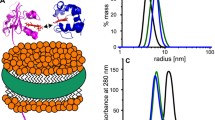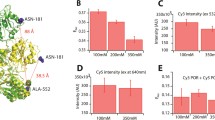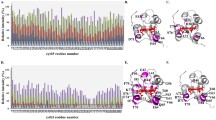Abstract
The biological toxicity of uranyl ion (UO 2+2 ) lies in interacting with proteins and disrupting their native functions. The structural and functional consequences of UO 2+2 interacting with cytochrome b 5 (cyt b 5), a small membrane heme protein, and its heme axial ligand His39Ser variant, cyt b 5 H39S, were investigated both experimentally and theoretically. In experiments, although cyt b 5 was only slightly affected, UO 2+2 binding to cyt b 5 H39S with a K D of 2.5 μM resulted in obvious alteration of the heme active site, and led to a decrease in peroxidase activity. Theoretically, molecular simulation proposed a uranyl ion binding site for cyt b 5 at surface residues of Glu37 and Glu43, revealing both coordination and hydrogen bonding interactions. The information gained in this study provides insights into the mechanism of uranyl toxicity toward membrane protein at an atomic level.

Impacts of uranyl ion on the structure and function of cytochrome b5 H39S variant



Similar content being viewed by others
References
Gorden AE, Xu J, Raymond KN, Durbin P (2003) Chem Rev 103:4207–4282
Vidaud C, Gourion-Arsiquaud S, Rollin-Genetet F, Torne-Celer C, Plantevin S, Pible O, Berthomieu C, Quéméneur E (2007) Biochemistry 46:2215–2226
Montavon G, Apostolidis C, Bruchertseifer F, Repinc U, Morgenstern A (2009) J Inorg Biochem 103:1609–1616
Michon J, Frelon S, Garnier C, Coppin F (2010) J Fluoresc 20:581–590
Pible O, Guilbaud P, Pellequer JL, Vidaud C, Quéméneur E (2006) Biochimie 88:1631–1638
Van Horn JD, Huang H (2006) Coord Chem Rev 250:765–775
Wegmer SV, Boyaci H, Chen H, Jensen MP, He C (2009) Angew Chem Int Edn 48:2339–2341
Lins RD, Vorpagel ER, Guglielmi M, Straatsma TP (2008) Biomacromolecules 9:29–35
Vergères G, Waskell L (1995) Biochimie 7:604–620
Wang WH, Wang YH et al (2002) Chem Lett 674–675
Chudaev MV, Gilep AA, Usanov SA (2001) Biochemistry (Moscow) 66:667–681
Wang WH, Lu JX, Yao P, Xie Y, Huang ZX (2003) Protein Eng 6:1047–1054
Sigman JA, Kwok BC, Lu Y (2000) J Am Chem Soc 122:8192–8196
Durley RC, Mathews FS (1996) Acta Crystallogr D 52:65–76
Wang ZH, Lin YW, Rosell FI, Ni FY, Lu HJ, Yang PY, Tan XS, Li XY, Huang ZX, Mauk AG (2007) Chembiochem 8:607–609
Humphrey W, Dalke A, Schulten K (1996) J Mol Graph 14:33–38
Kalé L, Skeel R, Bhandarkar M, Brunner R, Gursoy A, Krawetz N, Phillips J, Shinozaki A, Varadarajan K, Schulten K (1999) J Comput Phys 151:283–312
Yeung N, Lin YW, Gao YG, Zhao X, Russell BS, Lei L, Miner KD, Robinson H, Lu Y (2009) Nature 462:1079–1082
Baldwin DA, Marques HM, Pratt JM (1987) J Inorg Biochem 30:203–217
Moore GR, Pettigrew GW (1990) Cytochrome c: evolutionary, structural and physicochemical aspects. Springer, Berlin
Lin YW, Yeung N, Gao YG, Miner KD, Tian S, Robinson H, Lu Y (2010) Proc Natl Acad Sci USA 107:8581–8586
Lin YW, Yeung N, Gao YG, Miner KD, Lei L, Robinson H, Lu Y (2010) J Am Chem Soc 132:9970–9972
Lin YW, Wang WH, Zhang Q, Lu HJ, Yang PY, Xie Y, Huang ZX, Wu HM (2005) Chembiochem 6:1356–1359
Diederix RE, Ubbink M, Canters GW (2002) Biochemistry 41:13067–13077
Ren Y, Wang WH, Case M, Qian W, McLendon G, Huang ZX (2004) Biochemistry 4:3527–3536
Im SC, Waskell L (2011) Arch Biochem Biophys 507:144–153
Acknowledgments
We gratefully thank Prof. Zhong-Xian Huang at Fudan University, Shanghai, China, for providing the cytochrome b 5 gene and proteins, and Dr. Tianlei Ying at the National Institutes of Health (NIH), USA, for discussions regarding simulation of the uranyl ion. NAMD and VMD were developed by the Theoretical Biophysics Group in the Beckman Institute for Advanced Science and Technology at the University of Illinois at Urbana-Champaign, USA. This work is supported by the National Natural Science Foundation of China (NSFC Nos. 20877038, 10975069).
Author information
Authors and Affiliations
Corresponding author
Rights and permissions
About this article
Cite this article
Wan, D., Liao, LF., Zhao, MM. et al. Interactions of uranyl ion with cytochrome b 5 and its His39Ser variant as revealed by molecular simulation in combination with experimental methods. J Mol Model 18, 1009–1013 (2012). https://doi.org/10.1007/s00894-011-1097-1
Received:
Accepted:
Published:
Issue Date:
DOI: https://doi.org/10.1007/s00894-011-1097-1




